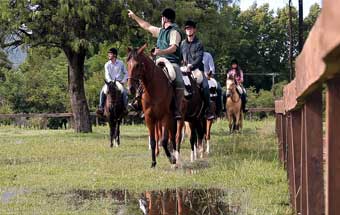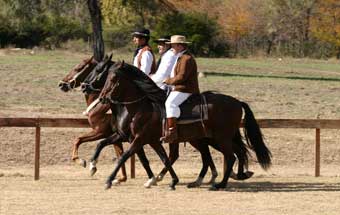Planning a horseback riding route
By: Pablo Imberti Posted: 30/10/2017
Ampascachi sonly offers horse riding holidays in Argentina.
Horse culture is part of Argentina’s traditions.
Exploring this country on horseback is an unforgettable experience.
Tips to plan a trail ride
If you want to enjoy a trail ride, you must take into consideration several aspects when planning it, among them the trails that should be comfortable to ride for both, the horse and rider.
Choosing the best trails for horse riding tours is based on various important aspects:
- Safe trails and paths for horses and riders
- Beautiful scenery and interesting places for tourists
- Infrastructure and logistics
- Professional Team
- Safety and Security
- Commercialisation and legislation
In this article we are going to describe point A, how to choose trails that are accessible and comfortable to ride.

Although there might be trails for trekking or cycling, they are not always suitable for horses as well. We explain, which criteria trails need to fulfil, e.g. width, grade, height, surface, possible river crossings and other obstacles or difficulties.
We are going to focus on the most interesting types of terrains and regions in Argentina with a wide range of diverse sceneries and culture for horseback riding tours.
Most routes in Argentina lead through arid, open landscapes or mountainous and virgin areas that are often uninhabited.
Trail width
How wide a trail should be, depends on where it goes through, e. g. plains, areas covered with vegetation, hills or mountains with flanks, canyons, etc.
When we ride in plains or open fields, the width is irrelevant as there is enough space, but a certain order within the group of riders should be respected.
Trails that lead through woods or areas abundantly covered with vegetation should be 1,20 m to 1,50 m wide to avoid to get scratches from the plants.
In the mountains, trails should be wide enough that a horse is able to step securely without any risk of slipping.
In canyons or passes it is important that the trail allows two horses to pass at the same time or that one horse is able to do a turn and therefore, it should be about 2,50 m wide.
Would you like to be part of a group with an equestrian soul?
Join the Ampascachi Community. Obtain exclusive benefits for your holidays.
We tell you how to start, train and take care of your horse.
Interviews with direct providers of riding tours around the world.
Opinions of outstanding equine scientists and personalities in the equestrian sport world.
Trail steepness
How steep a trail can be, depends on one hand on the experience of the riders and on the other hand on the weather conditions that may be given.
For beginners, a grade of 20% or less is recommendable, for experienced riders riders it can reach up to 40%.
These percentages are average values and may be higher on short sections.
Height
Trails should be high enough so that a rider can sit continuously and comfortably on the horse with no need to get off but in exceptional cases like low branches, tunnels, etc.
Surface
The surface has a big impact on the decision whether a trail is suitable for a riding tour or not.
You have to check if there are loose, slippery rocks or slab rocks on the trails that might be obstacles.
The conditions of the trail trail also determine rhythm and speed of the riding what must be taken into consideration for the tour.
Crossing rivers
Crossing a river can be dangerous because of the water depth and current.
It is not advisable to cross rivers that are deep. Every time you cross a river you have to check that there is no danger.
After heavy rains, the water level raises, so it is important to have the option to ride on an alternative trail instead of crossing the river.
Subscribe to the Ampascachi Community and obtain benefits and exclusive content. Furthermore, we offer free advice on horses and equestrian tourism.
Cattle grids
Cattle grids are ditches covered with long metal sticks with a certain distance in between them, that prevent livestock to cross as they cannot step on the narrow sticks.
Horses are also not able to cross cattle grids as their hooves may got stuck, but there is usually an alternative path or a gate to use.
When planning a route, we must reassure that in case there are cattle grids, there are also alternatives to cross with the horses.
In this article we have put emphasis on the importance to explore intensively the terrains where riding routes lead through. At Ampascachi, our logistics team organized professionally each tour to guarantee the safety of our guests.
following articles we are going to describe the other aspects to have in mind when planning a riding route (scenery, infrastructure, professional team, commercialisation and legislation).
Thinking about a horse riding holiday but don’t know how to book it?
Download our free eBook "How to plan your next horseback trip" and learn all you need to know when choosing the right holiday and outfitter for your next equestrian adventure.
~
THIS COULD ALSO BE INTERESTING

Tips for your horse riding holidays
What you should have in mind when planning your riding holidays: tips for your luggage and equipment, which precautions to take, travelling in group and accommodation.

Gaited Horses: Horses with a "Special Gait"
The basic gaits of most horse breeds are the walk, the trot and the canter or gallop. But other breeds have a special ambling gait which is more comfortable to ride than the trot.

Purmamarca and the Hill of Seven Colours
Purmamarca, a village in the Jujuy Province in Argentina, is situated in the foothills of the Hill of Seven Colours. This colourful mountain is part of the UNESCO World Heritage.
~
WHAT IS YOUR OPINION? LEAVE A COMMENT
Planning your horse riding holidays?
Join the Ampascachi Community. You will get exclusive advantages and guidance for your next horse riding holiday.


 German
German French
French Spanish
Spanish